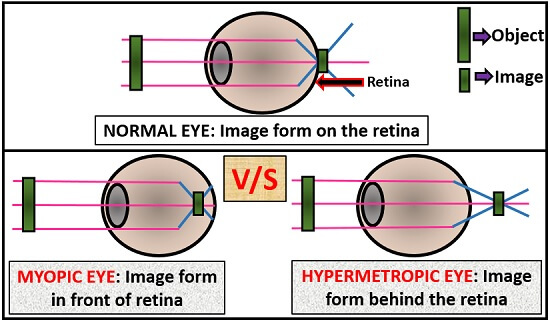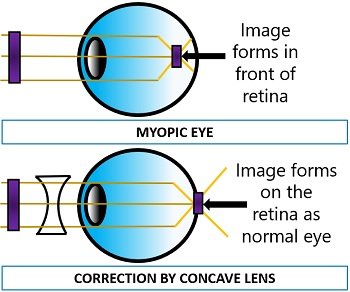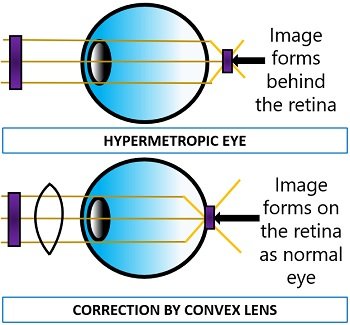The difference between myopia and hypermetropia is that a myopic person is only able to see near or short distance objects clearly. In contrast, a hypermetropic person is only able to see far or distant objects clearly. Both myopia and hypermetropia are the type of eye diseases that are based on the distance to see the object.
These two are the Refractive or Vision errors, where the image forms at different sites (either in front or behind the retina) due to a change in the size of an eyeball. In a myopic eye, the image forms in front of the retina and the image forms behind the retina in a hypermetropic eye, but not ‘on the retina’ as the normal eye.
Example: People who face difficulties in reading letters of a newspaper, at the time of cutting vegetables and while operating a mobile device etc. are some examples of hypermetropia. Oppositely, a person who faces difficulties in seeing distant vehicles while driving and in recognizing the face of a person standing far away etc. are a few examples of myopia.
Content: Myopia Vs Hypermetropia
- Comparison Chart
- Definition
- Diagram
- Video
- Correction
- Classification
- Complications
- Key Differences
- Conclusion
Comparison Chart
| Properties | Myopia | Hypermetropia |
|---|---|---|
| Alternative name | Near or Short sightedness | Far or distant sightedness |
| Nature | Clear visibility to the nearby objects | Clear visibility to the far objects |
| Image formation | Image is formed in front of the retina | Image is formed behind the retina |
| Effect on eye ball | Size of the eye ball increases | Size of the eye ball decreases |
| Focal length of the lens | Decreases | Increases |
| Effects | Retinal detachment, cataract, glaucoma etc. | Retinal detachment, glaucoma, amblyopia, strabismus etc. |
| Causes | Heredity, exposure to sunlight, body’s circadian rhythms etc. | Heredity, high blood pressure, weak functioning of ciliary muscle |
| Symptoms | Blurred image of distant object | Blurred image of near object |
| Treatment | By concave lens | By convex lens |
Definition of Myopia
It is also called Nearsightedness. It is a refractive error, in which a person can only see the nearby objects clearly, but the visibility to the distant object is not clear. Myopia is caused due to the more focusing power of an eye due to the large size of an eyeball. As a result, a myopic person when looking at distant objects, the light will fall in front of the retina (unlike a normal eye) and the image appears blurred or hazy.
Definition of Hypermetropia
It is also called Farsightedness and hyperopia. It is a refractive error, in which a person can only see the far objects clearly, but the visibility to the near object is not clear. Hyperopia occurs when the focusing power of an eye lens is low due to the small size of an eyeball. As a result, a hypermetropic person when looking at the nearby objects, the light will fall far back of the retina (unlike a normal eye) and the object appears blurred.
Diagram
The characteristic difference between the myopic and hypermetropic eye is in the formation of an image:
- In a myopic eye, the image forms in front of the retina.
- In the hypermetropic eye, the image forms behind the retina.
- Oppositely, the image forms on the retina in a normal eye.

This diagram depicts the comparison between the image formation in the normal eye with the myopic and hypermetropic eye.
Video: Myopia Vs Hyperopia
Correction
The correction of myopia is through the concave lens (diverging lens), which has a negative refractive power that increases with the severity of myopia.

And the correction of hypermetropia is through the convex lens (converging lens), which has a positive refractive power that also increases with the severity of hypermetropia.

Classification of Myopia and Hypermetropia
Based on the refractive error, myopia and hypermetropia can be classified into the following three types:
- Low
- Moderate
- High
Classification of myopia:
- Low myopia: In this, the refractive error is ≥ -3.00 D.
- Moderate myopia: In this, refractive error is ˂ -3.00 to -6.00 D.
- High myopia: In this, refractive error is ˂ -6.00 D.
Classification of hypermetropia:
- Low hypermetropia: In this, the refractive error is ≥ +2.00 D.
- Moderate hypermetropia: In this, refractive error is ˂ +2.00 to +5.00 D.
- High hypermetropia: In this, refractive error is ˂ +5.00 D.
Complications of Myopia and Hypermetropia
- Complications of myopia: These complications are based on the types of myopia, which are as follows:
- High myopia: It is a severe condition including complications like retinal detachment, cataract and glaucoma.
- Degenerative myopia: It is also called malignant myopia, which is a critical condition where the size of an eyeball increases very quickly. It has complications like retinal detachment, choroid neovascularization, glaucoma, strabismus and amblyopia.
- Complications of hypermetropia: It includes complications like retinal detachment, strabismus, amblyopia etc.
Terminologies for the complications that are caused by both myopia and hypermetropia are discussed below:
- Retinal detachment is the condition, by which the retinal membrane separates or detaches from the back of the eye.
- A cataract is a disease that causes the clouding of the eye lens.
- Glaucoma is a major problem that damages the optic nerve that plays a crucial role in transferring the signals that convert from images by the retina.
- Choroid neovascularization is a clinical condition, which causes the growth of abnormal blood vessels in the eye.
- Strabismus or “Crossed eye” is the condition where an eye cannot move in the same direction while looking at the object.
- Strabismus leads to amblyopia which is a medical condition also termed as “Lazy eye” and characterized by diminished vision.
Key Differences Between Myopia and Hypermetropia
- Myopia and hypermetropia are sometimes interchangeable with the terms nearsightedness and farsightedness, respectively.
- The nature of myopia and hypermetropia is the most important feature to distinguish between the two, in which a former affects the distant vision, but near objects are often clear to the eye, and a latter affects the near vision look, but the far objects are visible.
- The characteristic difference between the two is the image formation, wherein the image forms in front of the retina in the myopic eye, and behind the retina in the hypermetropic eye.
- The major effect is on the size of the eyeball, which increases in a myopic eye due to the decreases in focal length. Oppositely, the size of the eyeball decreases in a hypermetropic eye, which increases the focal length. The focal length of a lens is inversely proportional to the size of the eyeball, i.e. when the size of the eyeball increases, the focal length will decrease and vice versa.
- Both myopia and hypermetropia is refractive error, whose correction requires a different lens to correct these two conditions. The concave lens and convex lens is recommended for the treatment of myopia and hypermetropia.
Conclusion
Therefore, we can conclude that both myopia and hypermetropia are refractive errors, i.e. the clinical condition that occurs due to the change in the size of an eyeball and the light or the image not focusing on the retina like a normal eye. These two conditions result due to heredity, muscle dysfunctioning of an eye, trauma etc.